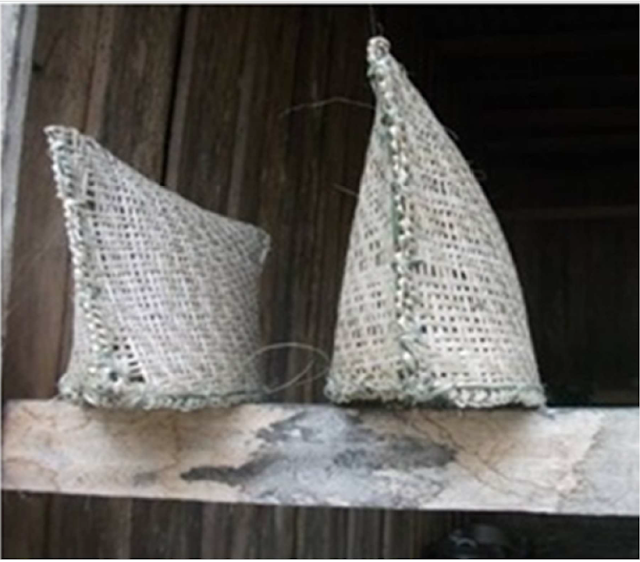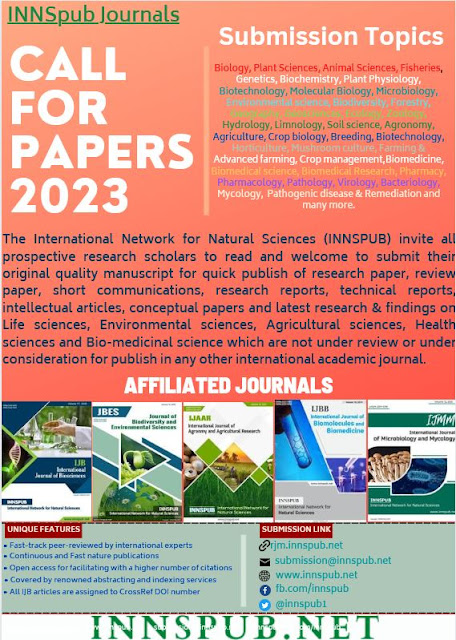Author Name
Pamphile Nguema Ndoutoumou, Gino Boussiengui Bousssiengui, Armelle Lyvane Ntsame Affane, Charlène Kady Ignanga Mouyombi, and Crépin Ella Missang.
Journal Name
International Journal of Agronomy and Agricultural Research | IJAAR
Publisher
International Network For Natural Sciences | INNSpub
Abstract
The forests of the Congo Basin cover an area of 200 million hectares, of which just over 10% is in Gabon. In this country, crop products and non-timber forestproducts (NTFPs) are abundant because of its favourable climate. There is significant biodiversity and great potential for non-timber forest products. This study is interested in the identification and the supply chain of the Marantaceae, one of these NTFPs of plant origin in central Gabon, whose exploitation is national. Through a survey of the main actors in the sector and field visits in the locality of Bifoun, it emerges the existence of three large groups of exploited marantaceae, whose harvest and transport are mainly done by women, in various containers. The storage of this NTFPs does not exceed four days, with the risk of losing its commercial value due to drying out. The uses of this resource are multiple: processing cassava, cooking food, making handicrafts, etc. The income it provides to producers is mainly use towards small family expenses but helps to monetize the rural world. The difficulties inherent in the distance from harvesting points, the low price of the product and the impossibility of long-term storage of the marantaceae leaves constitute a brake on the development of this activity. It would therefore be wise to envisage the domestication of the species listed for a sustainable use of this plant genetic resource.
Introduction
Non-timber forest products (NTFPs), through their multiple uses, contribute to the subsistence of populations and provide them with income (Shankar et al., 2001; Walter, 2001; Mbolo et al., 2002; Biloso & Lejoly, 2006; Vermeulen et al., 2009). The use of various categories of non-timber forest products is sometimes the only source of income for some rural populations (Nguenang et al., 2010; Thiombiano et al., 2010; Ngoya-Kessy, 2011). In recent years, NTFPs have considerably aroused interest worldwide as it contribution to household economy and food security is increasingly recognized (Lescuyer, 2010; Loubelo, 2012), as well as to the achievement of environmental objectives such as the conservation of plant biodiversity (Arnold & Ruiz, 2001; Doucet, 2006; Tchatat & Ndoye, 2006). According to the above- mentioned authors and Lehoux and Chakib (2012), these products play a role in terms of food, economic value and their usage for divers purposes (Sunderland et al., 2003; Tchiegang & Mbougueng, 2005; Betti & Lejoly, 2010; Priso et al., 2011).
Related article Research Paper | Extreme weather events and their impact on urban crop production By INNSPUB Journals
These are monocotyledons with fairly significant genetic variability, which offers many uses to the populations. For example, the use of Haumania liebrechtsiana (De Wild. & T. Durand) is preferred over other Marantaceae because of its flexible stem used for building huts, basketwork and making fishing vessels. The bevelled pieces of internodes are also used to build cages for rat traps. The stem rings can be made and used to hold bundles of wood and leaves (Tchatat & Ndoye, 2006). According to the same authors, the stems of Hypselodelphys violacea (Ridl.) are also used for traps making. The rings formed with these stems are used to hold together bundles of wood and leaves. The strips detached from the petiole of Marantochloa manii (Benth.) are used in basketry, in cooking as ties for cassava sticks and various packets of food, as well as ties for bundles Marantaceae leaves. According to Ndouano & Ada-Ntoutoume (2002), the leaves of Megaphrynium macrostachyum (Benth.) were used as vegetable roof tiles to cover huts or waterproof clothing. However, the most prominent use of those leaves is for food packaging (e.g., cassava sticks) as well as food storage and food cooking of various types of food products. The cortical strips of the petioles (free from the pith) are used for weaving fishing tools, but also as ties to fix the leaves on the roofs or consolidate bundles. The short leaves of Sarcophrynium brachystachys (Benth.) are widely used by women for wrapping short cassava sticks.
The
aim of this present study is twofold: firstly, to identify the species of Marantaceae
exploited by the peasants in the central Gabon, and secondly laying the
foundations of the domestication of this perishable resource. This study is
therefore of multiple interest, from a social, economic, ecological and
scientific standpoint. Check out more by following the link Identification and marketing of Marantaceae in the Ndjolé area, in central Gabon
Reference
Arnold JEM, Ruiz PM. 2001. Can non-timber forest products match tropical forest conservation and development objectives ? Ecological Economics 39, 437-447.
Betti JL, Lejoly J. 2010. Contribution à la connaissance des plantes médicinales de la réserve de biosphère du Dja au Cameroun : plantes utilisées dans le traitement des maux de dos. Intern. Journ. of Biolog. and Chem. Sc. 4(1), 193-200.
Biloso A, Lejoly J. 2006. Etude de l’exploitation et du marché des produits forestiers non ligneux à Kinshasa. Tropicultura 24(3), 183-188.
Cabezas FJ, De la Estrella M, Aedo C, Velayos M. 2005. Marantaceae of Equatorial Guinea. Ann. Bot. Fennici 42, 173-184. ISSN 0003-3847.
Doucet JL. 2006. L’alliance délicate de la gestion forestière et de la biodiversité dans les forêts du Centre du Gabon. Thèse de doctorat, Faculté Universitaire des Sciences Agronomiques de Gembloux, Belgique. 390 pp.
Koechlin J. 1964. Scitaminales : Musacées, Strélitziacées, Zingibéracées, Cannacées, Marantacées. — In : Aubréville, A. (ed.) Flore du Gabon 9, 1-172. Musée National d’Histoire Naturelle, Paris, France.
Lehoux H, Chakib A. 2012. Rapport provisoire PFNL au Gabon. Food and Agriculture Organization, FOPP. http://www.fao.org/forestry/nwfp/78836/fr.
Lescuyer G. 2010. Importance économique des produits forestiers non ligneux dans quelques villages du Sud-Cameroun. Bois et Forêts des Tropiques 304(2), 15-24.
Lompo D, Ouedraogo M, Theilade I, Boussim IJ. 2007. Use of Non-Wood Forest Products by local people bordering the “Parc National Kaboré Tambi”, Burkina Faso. The Journal of Transdisciplinary Environmental Studies 6(1), 21.
Loubelo E. 2012. Impact des Produits Forestiers Non Ligneux (PFNL) sur l’économie des ménages et la sécurité alimentaire : cas de la République du Congo. Thèse de Doctorat, Université Rennes 2, France, 260 pp.
Mbolo M, Walter S, Lejeune J. 2002. La collecte et l’analyse des données statistiques sur les Okafor JC, 1980. Edible indigeneous woody plants in the rural economy of the Nigerian forest zone. For. Ecol. Man 3, 45-65.
Ndouano A, Ada-Ntoutoume E. 2002. Utilisation des produits forestiers non-ligneux dans le cadre de la gestion forestière durable au Gabon.
Ngoya-Kessy AM. 2011. Commerce responsable des produits forestiers : Rôle des Etats dans le processus de certification des concessions forestières dans le bassin du Congo: Cas du Congo Brazzaville. Communication lors du séminaire international sur la gestion des forêts comme outil de coopération et de développement rural en Afrique Centrale.
Nguenang GM, Fongnzossie FE, Nkongmeneck BA. 2010. Importance des forêts secondaires pour la collecte des plantes utiles chez les Badjoué de l’Est Cameroun. Tropicultura 28(4), 238-245.
Nyare EN, Bouanga E, Ntoutoume C. 2012. Stratégie nationale et plan d’actions pour le développement du secteur des produits forestiers non ligneux en République Gabonaise. Projet GCP/ RAF/441/GER.
Priso RJ, Nnanga JF, Etame J, Din-Ndongo, Amougou-Akoa. 2011. Les produits forestiers non ligneux d’origine végétale : valeur et importance dans quelques marchés de la région du Littoral – Cameroun. J. of Appl. Biosci. 40, 2715-2726.
Schackleton S, Shanley P, Ndoye O. 2007. Invisible but viable : recognising local markets for Non-Timber Forest Products. Intern. of Forestry Review 9(3), 697-712.
Shankar U, Lama SD, Bawa KS. 2001. Ecology and economics of domestication of non-timber forest products: an illustration of Broomgram in Darjeeling Himalaya. Journal of Tropical Forest Science 13(1), 171-191.
Sunderland TCH, Besong S, Ayeni JSO. 2003. Distribution, utilization and sustainability of Non-Timber Forest products from Takamanda Forest reserve, Cameroon. In: Comiskey. J. A., Sunderland, T. C. H., Sunderland, G. J. L. (eds) 2003. Taka Manda: The biodiversity of an African Rainforest, SI/MAB Series c 8, 155-172.
Tchatat M, Ndoye O. 2006. Étude des produits forestiers non ligneux d’Afrique centrale : réalités et perspectives. Bois et Forêts des tropiques 288(2), 27-39.
Tchiegang C, Mbougueng PD. 2005. Composition chimique des épices utilisées dans la préparation du Nah-poh et du Nkui de l’Ouest Cameroun. Tropicultura 23(4), 193-200.
Thiombiano DNE, Lamien N, Dibong SD, Boussim IJ. 2010. Etat des peuplements des espèces ligneuses de soudure des communes rurales de Pobé-Mengao et de Nobéré (Burkina Faso). Journal of Animal & Plant Sciences 9(1), 1104-1116.
Vermeulen C, Schippers C, Larrubia CJ, Ntoune M, Bracke C, Doucet JL. 2009. Enjeux méthodologiques autour des produits forestiers non ligneux dans le cadre de la certification en Afrique Centrale. Bois et Forêts des Tropiques 300(2), 69-78. DOI: 10.19182/bft2009.300.a20416
Walter S. 2001. Non-Wood Forest Products in Africa: a regional and national overview. EC-FAO. http://www.fao.org/docrep/019/y1515b/y1515b.pdf


















0 comments:
Post a Comment